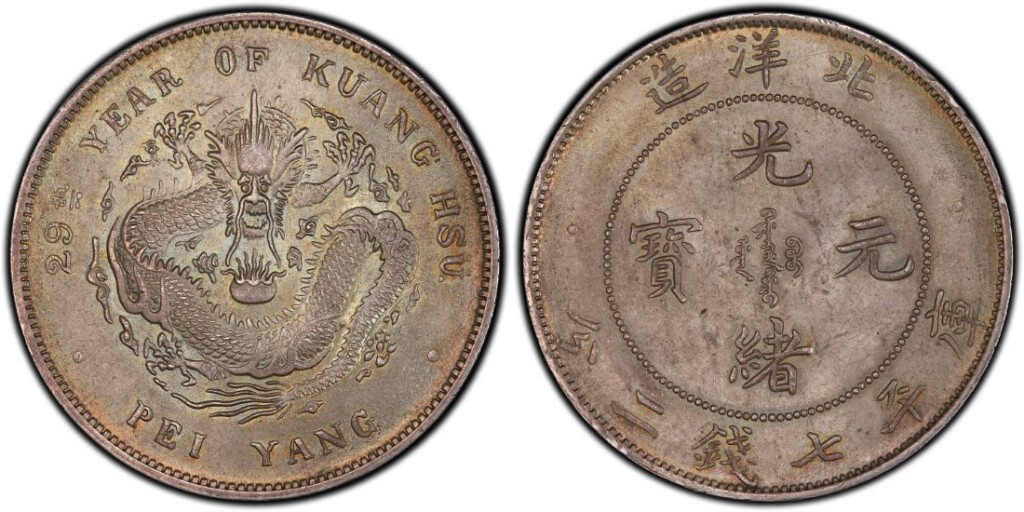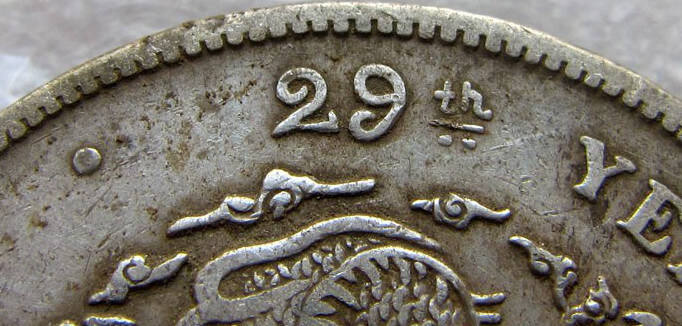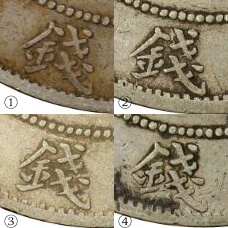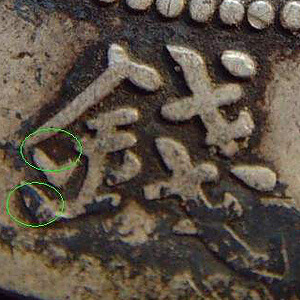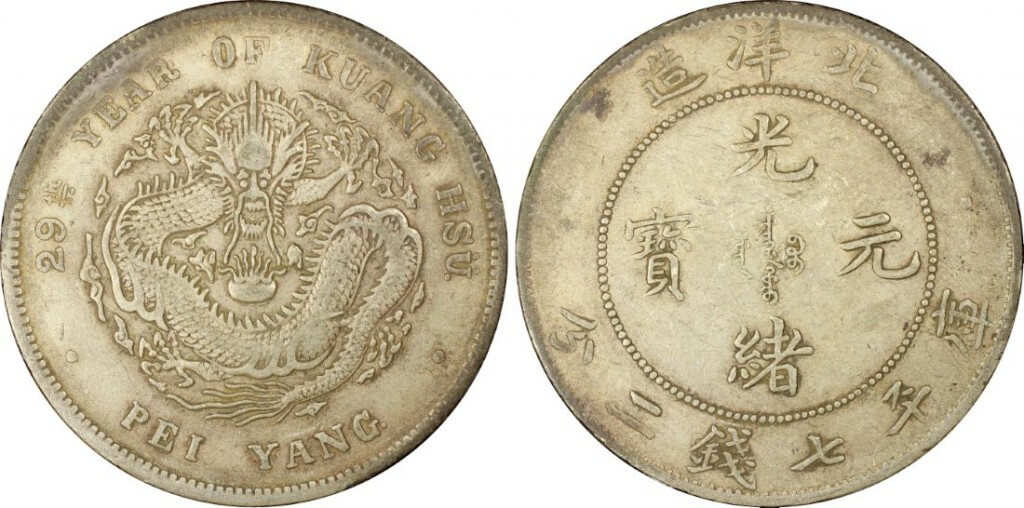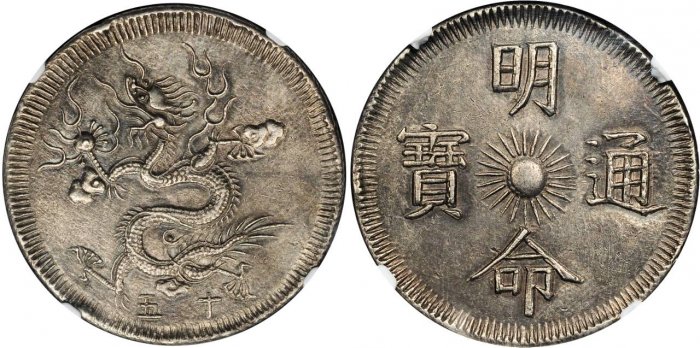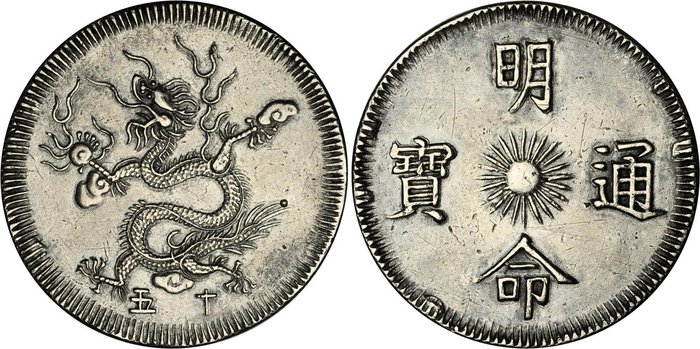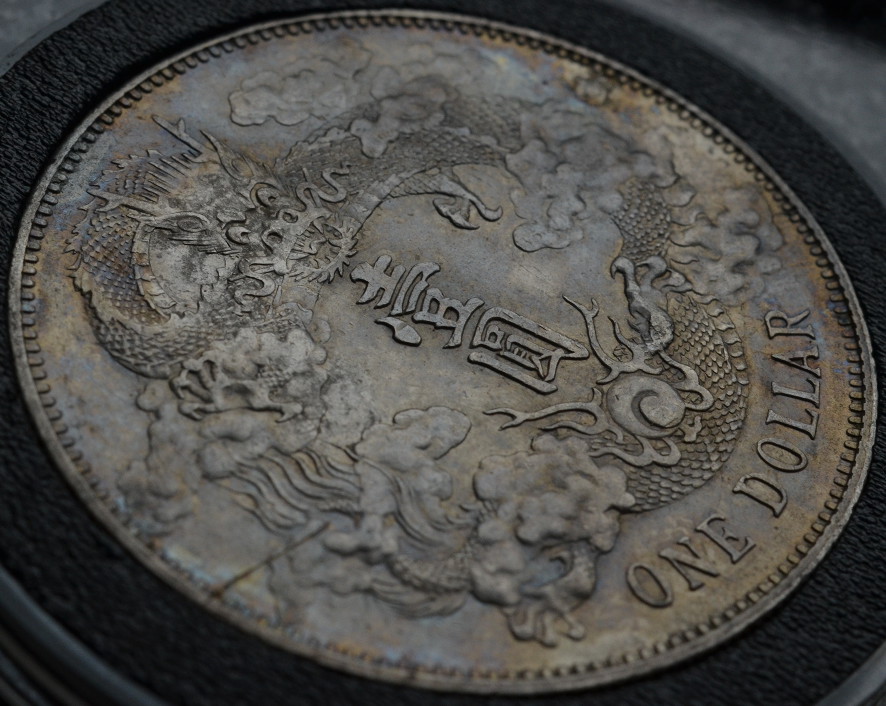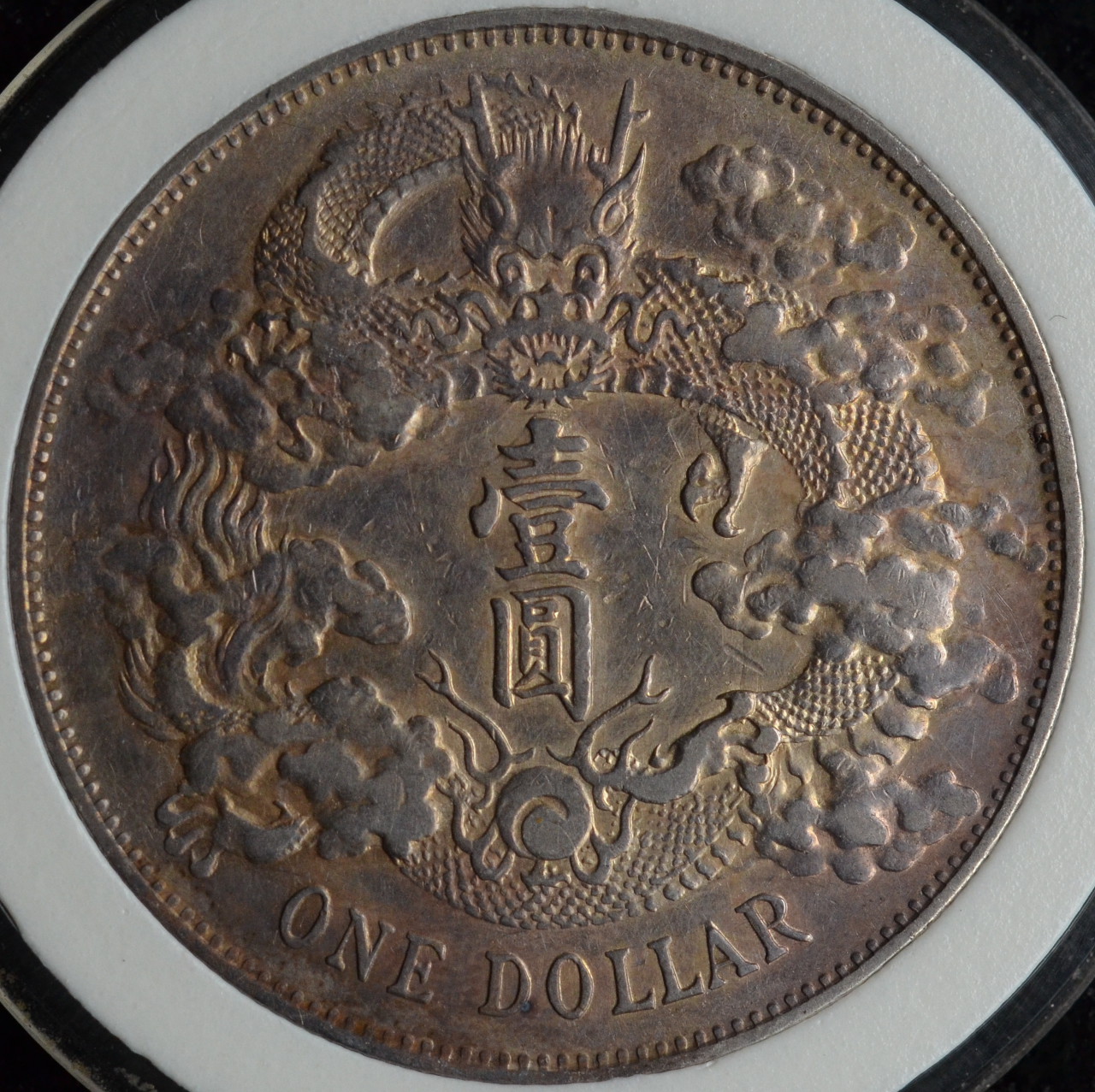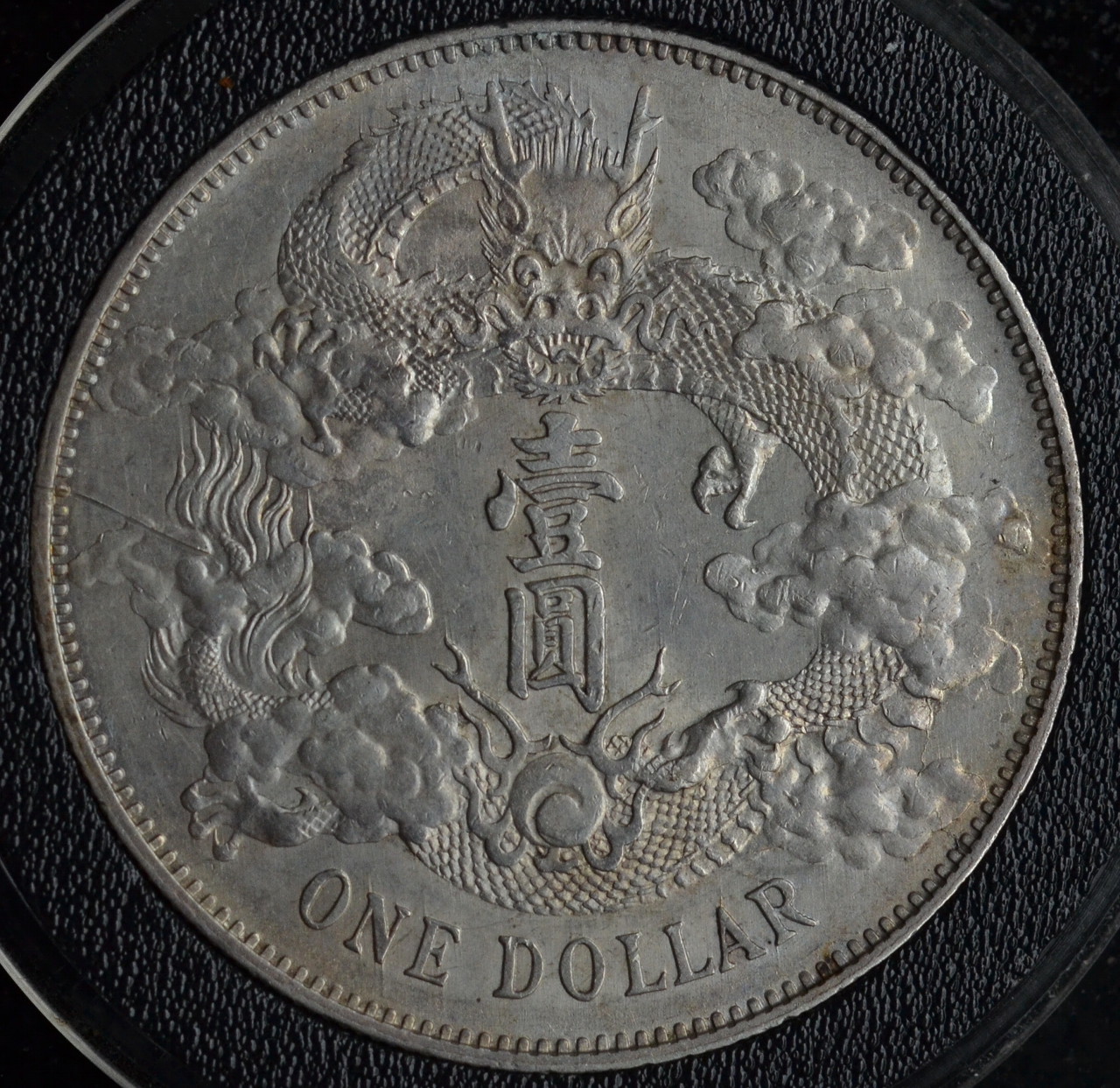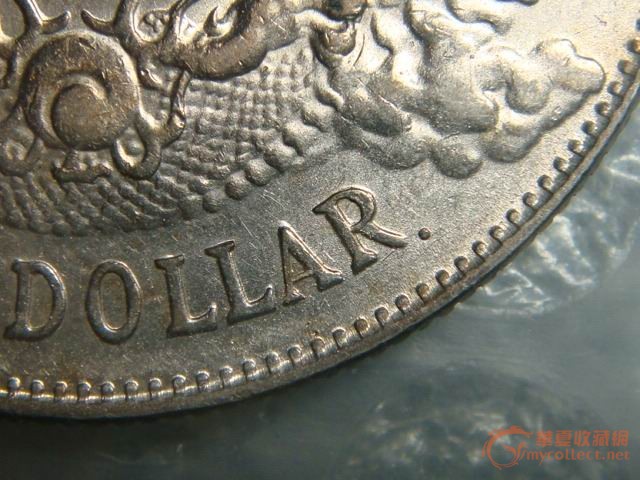The 1903 Chihli dollar (Y73.1) is much scarcer than its sister Chinese silver dollar, the famous Y73.2 made in 1908 (see related articles), but it is also somewhat less studied. Currently, only the variety with a full-stop after PEIYANG is acknowledged by grading agencies. There exists actually much more interesting and rare varieties, which are actively sought after in China. Similarly to the 1908 Chihli dollar, this 1903 dragon coin has been minted in several version with different typography for the date. The most dramatic is the 艺术字 (artistic font):
Besides the roman numerals, another device to examine carefully is the 錢 character on the reverse of the coin. On the full-stop after PEI YANG coins, the 金 part (radical) on the left of the 錢 character has been calligraphied in four different ways:
The picture 1 is representative of what you see on 90% of Y73.1 dragon dollars: this is the most common variety. The calligraphy shown on picture 3 is called 中折金 and is much scarcer: both side strokes of the 金 radical are curved in a very noticeable way. Even more rare, the 挑金 variety (picture 2) is easily identified by its incurved left stroke. The rarest of all the varieties is the 双折金, with characteristic vigorous tapered strokes on the side and bottom (see picture 4 and details).
If like me you collect Pei Yang 29th year Chinese silver dollars, be on the lookout for these rare varieties: while they enjoy some popularity in China, most collectors abroad are still unaware of them, so there is good opportunities around.
This large silver coin could be a riddle even for Chinese readers. The reverse is similar to traditional Chinese coins – the name of the ruling Emperor, here “明命” (Míng Mìng in mandarin) and the characters 通寶 (coin of the realm). The obverse depicting the classical imperial flying dragon motif is also reminiscent of Chinese coinage, but its style and execution is unusual. Finally there is a date: 十五, 15th year of this Emperor era… It all looks all so very familiar, but there never was a “Ming Ming” emperor in China. Indeed, this coin is actually an early Vietnamese coin, issued in 1834, the 15th year of the rule of Emperor Minh Mạng!
Modern Vietnamese language is written using the latin alphabet, sprinkled with a lot of interesting diacritics, but this was not always the case. During their long history, Vietnam and China weaved a complex relationship together. For one millenium Vietnam was actually a Chinese vassal state, and this left a profound imprint on Vietnamese culture. China brought the Confucian society structure and Chinese characters to Vietnam, where they continued to evolve independently way after Chinese influence in the region had waned. This shared cultural background is the reason why this coin looks so familiar to the Chinese coin collector, in an uncanny way.
This “Minh Mạng thông bảo” coin has a face value of 7 tiền and 2 phân. The “tiền” unit is roughly similar to the Chinese 钱 (qián) unit we are accustomed to, and this silver coin weighs unsurprisingly about 27 grams. Its diameter is also comparable to Chinese dragon dollars at 40mm, but it actually predates them from half a century! The first Western-style dollar coins of the Asian continent were indeed actually made in Vietnam in 1832. Emperor Minh Mạng, despite the disdain he showed for European culture, had some interest for their technology and weaponry, which he sometimes imported in the otherwise very conservative Vietnamese society. These dollar coins are probably the result of one such experiment.
Vietnamese dollars were not machine struck – the Palace lacking a modern mint – but the blanks were cast like traditional cash coins then the design hammered. The fine details and sharpness of their surfaces despite being made with such a crude process is a testament to the care and mastery with which they were produced. Due to this process a lot of varieties exist, but these coins are rare, moreover in good condition and with sharp details. The coin pictured above is the most common variety for the year 1834, the stylized flames around the fireball in the dragon’s claws having two “forks”. A scarcer variety for the same year only has one of such “forks”.
These dragon dollars were nicknamed Phi Long, the Vietnamese reading for the Chinese characters 飞龙 (Fēi lóng). While they are very scarce and beautiful, these coins are still cheaper than Chinese coins of similar rarity: a 1834 7 tiền coin in AU grade is worth about $2500 USD at the time of this writing. The price of Vietnamese coins has risen sharply in recent years though, following the growth of the Chinese numismatic market. The shared cultural themes between the two countries makes old Vietnam coins attractive to Vietnamese and Chinese collectors alike. For example, the design of the rare 5 tiền coin shown below, made during the rule of Emperor Tự Đức, is actually a great visual pun with an auspicious meaning! Continue reading »
Some readers have asked which dragon dollar is the most popular amongst collectors. The most famous chinese silver dollar from the late Qing era is most likely the Y31 silver dollar, colloquially referred to as “宣三” in China. It was minted in 1911 (3rd year of the rule of Xuan Tong) at the Central Mint in Tianjin. It was the last imperial coin issued before the regime was toppled by the Xinhai revolution. The design of this chinese silver dollar is considered by many collectors to be the most beautiful, and it is also the only imperial chinese coin bearing the “ONE DOLLAR” face value to have been circulated. While not rare by any measure, the Y31 dollar has seen its market value rise steeply in recent years due this popularity.
This dragon dollar was issued by the central authority, which means it had standardised weight, metal composition and design, but there exists nonetheless three die variations of this chinese coin.
The most commonly seen is called “浅版” in China, or “shallow strike version” (see below). Since it was struck with old dies, the details of the design are less clear in this version than in early ones. By looking carefully at the DOLLAR word on the reverse, one can see that the R was repaired by adding back a missing leg. It is labelled as “w/o Flame, w/o Dot” by PCGS:
The earliest version is called “深版“, or “deep strike version”. The details of this version are very sharp, the R in DOLLAR is still intact, and an additional spine which was lost to weak strike or die deterioration in subsequent versions is still visible at the tip of the tail of the dragon, across the cloud. While this version is only slightly scarcer than the 浅版, it is usually more expensive due to its popularity. This coin is labelled “Extra flame” by PCGS, due to the “additional” spine at the end of the tail of the dragon:
The last version is actually a restrike of the 浅版. In the years following the 1911 revolution, old dies were reused to issue new coins and avoid currency shortages. The already well worn dies of the 浅版 Y31 were briefly reused to mint the Y31.1 dollar, much scarcer than the earlier “official” issues. The only difference with the original dies is the addition of a dot after the word “DOLLAR“. Similar alterations were done to other revolutionary restrikes, like the 1904 Kiang Nan dollar with dots in the denomination.
Since the Y31.1 dollar is much more rare and expensive than other versions, many unscrupulous coin dealers or counterfeiters have tooled genuine dollars to add a silver dot, thus instantly doubling their profits. Most of these coins have been polished or cleaned first, though, to make the modification less obvious.
It is therefore advised to avoid buying cleaned or polished Y31.1 dollars. Genuine coins from the type “dot after dollar” (带点) were all made using the “w/o Flame, w/o Dot” 浅版 dies, so they have the same characteristics: fixed “R”, unclear details, and one spine less on the dragon tail. Uneven toning around the dot should be considered with extreme suspicion. A dot on a “Extra flame” dollar is a certain indication of tooling. Once again, be careful when buying chinese coins!
